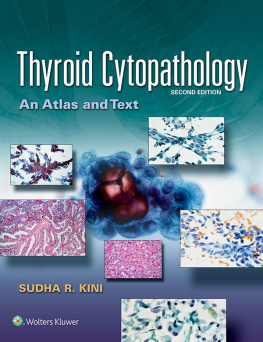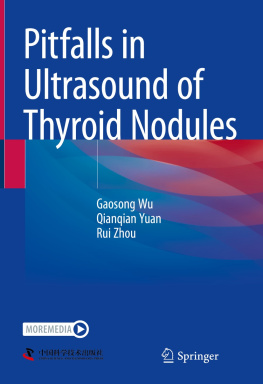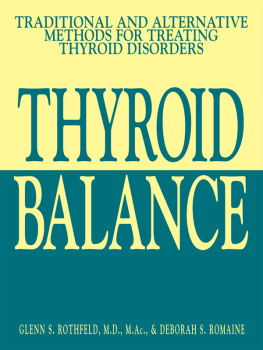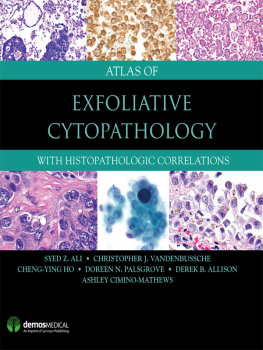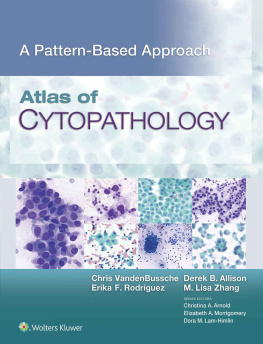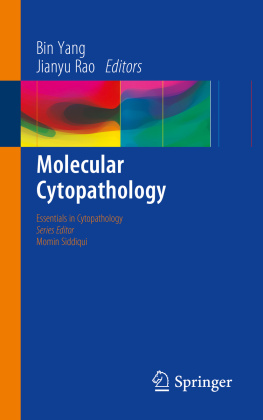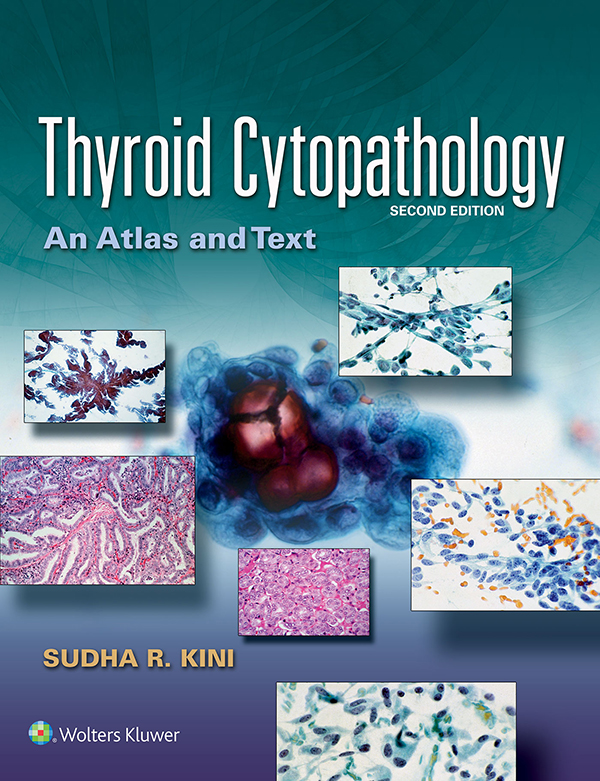
Thank you
for purchasing this e-book.
To receive special offers and news
about our latest products,
sign up below.

Or visit LWW.com

Thyroid Cytopathology
SECOND EDITION
Sudha R. Kini, MD
Formerly Division Head (retired), Cytopathology
Department of Pathology
Henry Ford Hospital
Detroit, Michigan

Acquisition Editor: Ryan Shaw
Product Development Editor: Kate Marshall
Production Project Manager: David Saltzberg
Design Coordinator: Stephen Druding
Manufacturing Coordinator: Beth Welsh
Prepress Vendor: S4Carlisle Publishing Services
Second edition
Copyright 2015 Wolters Kluwer Health
Copyright 2008 Lippincott Williams & Wilkins, a Wolters Kluwer business All rights reserved. This book is protected by copyright. No part of this book may be reproduced or transmitted in any form or by any means, including as photocopies or scanned-in or other electronic copies, or utilized by any information storage and retrieval system without written permission from the copyright owner, except for brief quotations embodied in critical articles and reviews. Materials appearing in this book prepared by individuals as part of their official duties as U.S. government employees are not covered by the above-mentioned copyright. To request permission, please contact Wolters Kluwer Health at Two Commerce Square, 2001 Market Street, Philadelphia, PA 19103, via email at (products and services).
987654321
Library of Congress Cataloging-in-Publication Data
Available upon request
ISBN 978-1-4511-9389-3
eISBN 978-1-4963-1836-7
Care has been taken to confirm the accuracy of the information presented and to describe generally accepted practices. However, the author(s), editors, and publisher are not responsible for errors or omissions or for any consequences from application of the information in this book and make no warranty, expressed or implied, with respect to the currency, completeness, or accuracy of the contents of the publication. Application of this information in a particular situation remains the professional responsibility of the practitioner; the clinical treatments described and recommended may not be considered absolute and universal recommendations.
The author(s), editors, and publisher have exerted every effort to ensure that drug selection and dosage set forth in this text are in accordance with the current recommendations and practice at the time of publication. However, in view of ongoing research, changes in government regulations, and the constant flow of information relating to drug therapy and drug reactions, the reader is urged to check the package insert for each drug for any change in indications and dosage and for added warnings and precautions. This is particularly important when the recommended agent is a new or infrequently employed drug.
Some drugs and medical devices presented in this publication have Food and Drug Administration (FDA) clearance for limited use in restricted research settings. It is the responsibility of the health care provider to ascertain the FDA status of each drug or device planned for use in his or her clinical practice.
LWW.com
DEDICATED TO
Late Dr. John K. Frost, whose Basic Concepts to General Cytopathology served as a foundation for my cytopathology learning process and practice
AND
Late Dr. J. Martin Miller, for his deep concerns for the patients, his enthusiasm in launching the thyroid fine needle biopsy project in 1976, for his excitement with the success of and strong faith in the utility of thyroid needle biopsies, both fine and large, in reducing unnecessary thyroid surgeries
AND
As always, to the loving memories of my late husband, Dr. Ratnakar Kini
The landmark event in the field of Thyroid Cytopathology was the State of the Science consensus meeting sponsored by the National Cancer Institute (NCI), Bethesda, Maryland, in 2007. The intention was to bring uniformity and consistency to the diagnostic terminologies for reporting the cytopathologic findings of thyroid aspirates and management strategies across the medical community. The proceedings of this meeting were referred to as Bethesda System for Reporting Thyroid Cytopathology (BSRTC). At the time the previous edition of this atlas went to press, in late 2007, the proceedings of the consensus meeting were unavailable for publication. One of the main reasons for this edition is to present BSRTC, since, it is widely accepted, utilized, and popular among all the disciplines dealing with thyroid diseases in the United States. The reasons are several.
The six-tiered BSRTC system has amply simplified the reporting of the cytopathologic findings of thyroid aspirates. BSRTC has ended the dilemma many cytopathologists/pathologists faced in interpreting minimal or borderline changes, or separating nonneoplastic from neoplastic follicular/Hrthle cell lesions. Category 3 of BSRTC includes aspirates with any degree of atypia, something cytopathologists have had a hard time categorizing and communicating their findings/concerns to the clinicians. By recommending the terms Follicular Lesions of Undetermined Significance (FLUS) or Suspicious for Follicular/Hrthle cell lesion in Category 4, BSRTC has eliminated the frustrations trying to separate nonneoplastic and neoplastic follicular and Hrthle cell lesions; or benign from malignant follicular/Hrthle cell tumors. BSRTC has also provided the risk for malignancy in each category, so that management strategies have been easier and consistent. Now most everyone speaks the same language when it concerns thyroid cytopathology.
In this atlas, however, I have chosen to retain the reporting scheme for thyroid aspirates that was used at Henry Ford Hospital, Detroit. This reporting system was developed over the last several years with the blessings of endocrinologists and endocrine surgeons. The reporting categories were based on the fact that follicular and Hrthle cell neoplasms could be recognized cytologically (contrary to the general belief) and could be separated, in most instances, from nonneoplastic lesions. This practice of cytopathology of thyroid was followed ever since the thyroid FNA biopsies were launched in 19761977 to this date, with a primary goal of reducing unnecessary thyroid surgeries. Replacing the existing reporting system totally with the BSRTC would mean negating all the criteria and description of cytologic features of these lesions presented in this atlas.
The clinicians at the authors institution were comfortable with the existing reporting system. But in order to be in synch with the rest of the Cytology world, both systems have now been integrated. describes both reporting systems in detail. I sincerely thank Dr. Dina Mody for presenting the BSRTC succinctly and clearly.
What else is new and/or current in the field of Thyroid Cytopathology? I have noted that the liquid-based cytologic preparations of thyroid aspirates are fast becoming very popular owing to the simplicity of specimen collection, with no dependence on assistance for making thin smears, no worries about prompt fixation and air-drying, less manual labor for cytopreparation, and only one slide to examine per case. The previous edition of this atlas included an Appendix for liquid-based technology. In this edition, I have included it (liquid-based technology) along with traditional methods and integrated the images from liquid-based preparations with the wet-fixed Papanicolaou-stained and air-dried Romanowski-stained preparations. I personally prefer spray-fixed material stained by the Papanicolaou method. Readers can appreciate this fact while reviewing images of lesions prepared and stained by different techniques. The cytologic criteria described and illustrated in this atlas are entirely based on spray-fixed material stained by the Papanicolaou method. I firmly believe that the interpretation of a cytologic specimen not only requires appreciation of the pattern but, most importantly, the nuclear details such as those presented in the Papanicolaou-stained wet-fixed, direct smears.
Next page
